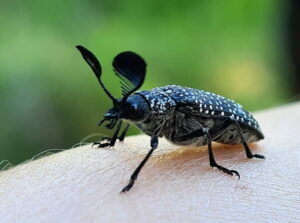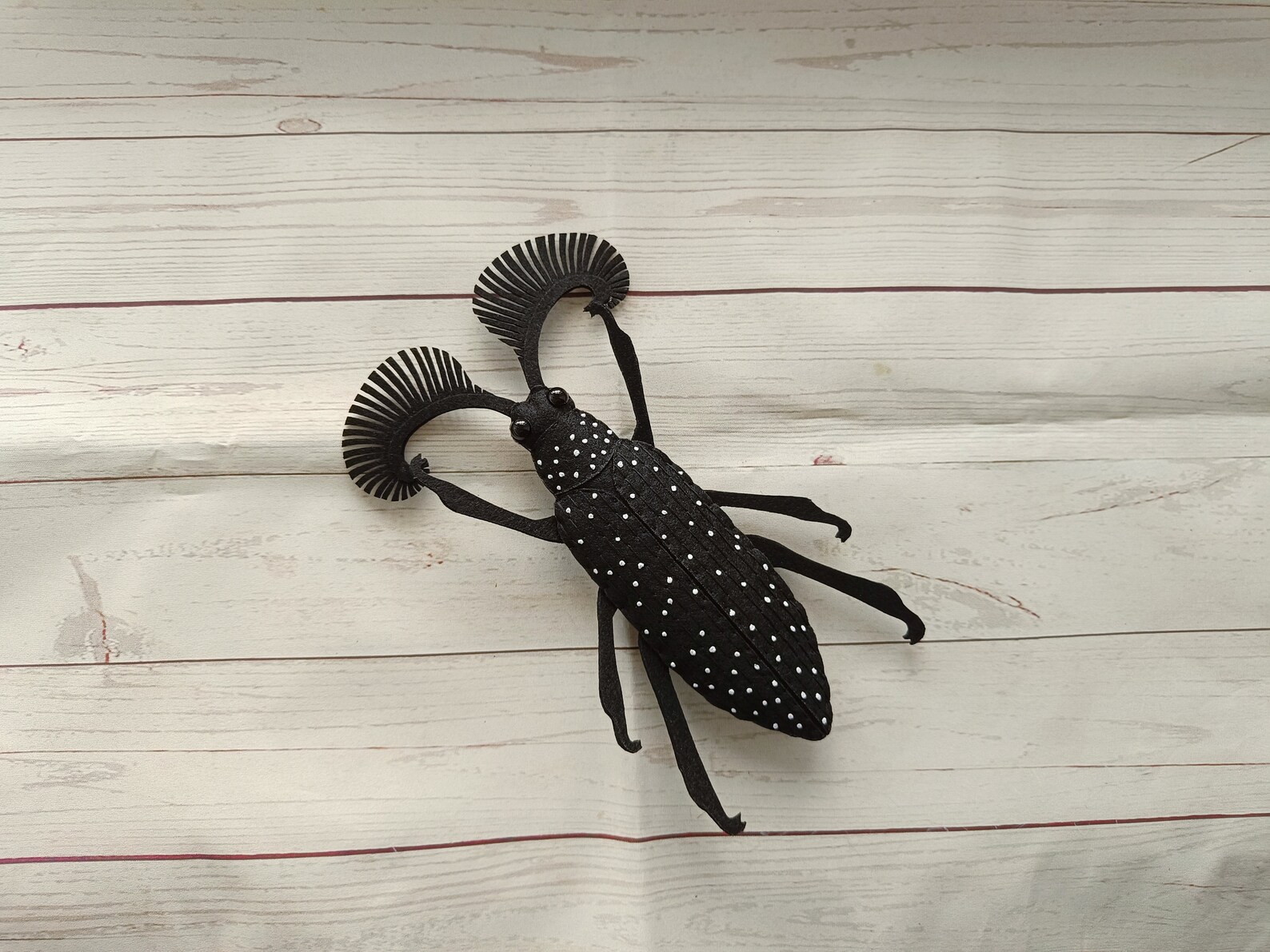Description
Feather Horned Beetle: A Comprehensive Guide
The Feather-Horned Beetle, scientifically known as Rhipicera femorata, is a fascinating species of beetle native to Australia. With its striking appearance and unique features, it has captured the interest of entomologists and insect enthusiasts alike. This guide explores its habitat, characteristics, flying abilities, and other intriguing facts to help you better understand this remarkable insect.

What Is the Feather Horned Beetle Habitat?
The Feather-Horned Beetle is primarily found in open eucalypt forests across southeastern Australia, including regions from southern Queensland to Tasmania and southwestern Australia. These environments provide the beetle with ample resources for survival, including shelter among trees and access to cicadas, which are believed to be hosts for their parasitic larvae.
Key Habitat Features:
-
Location: Southeastern and southwestern Australia.
-
Environment: Open eucalypt forests.
-
Diet: Carnivorous; larvae may parasitize cicadas.
What Are Horned Beetles?
Horned beetles are a group of insects characterized by prominent horn-like projections on their heads or thoraxes. These structures are typically found in males and serve purposes such as combat during mating seasons or digging. Horned beetles include species like rhinoceros beetles, elephant beetles, and atlas beetles.
Key Facts About Horned Beetles:
-
Diet: Herbivorous (most species).
-
Behavior: Solitary and nocturnal.
-
Distinctive Feature: Horn-like projections used for mating or digging.
Can a Horned Beetle Fly?
Yes, horned beetles can fly despite their intimidating appearance and seemingly cumbersome horns. They possess two pairs of wings: the hardened forewings (elytra), which protect the delicate flying wings (alae) underneath. Studies have shown that even large horns have negligible aerodynamic impact on flight performance, allowing these beetles to fly efficiently.
Flying Abilities of Horned Beetles:
-
Wing Structure: Hardened elytra shield fragile alae.
-
Flight Impact of Horns: Minimal drag or weight increase.
-
Role in Ecosystems: Pollination and resource transportation4.
Are Horned Passalus Beetles Good or Bad?
Horned Passalus Beetles play an essential role in ecosystems by breaking down decaying wood and recycling nutrients. While they may seem intimidating due to their size and horns, they are beneficial insects that contribute to forest health. Their presence is often considered a sign of a thriving ecosystem.
Benefits of Horned Passalus Beetles:
-
Decomposers: Aid in breaking down organic matter.
-
Non-harmful: Do not pose risks to humans or plants.
Is the Feather Horned Beetle Dangerous?
The Feather-Horned Beetle is not dangerous to humans. Despite its striking fan-like antennae and carnivorous diet, it does not sting or bite humans1. Its larvae are thought to parasitize cicadas, but this behavior does not impact human activities directly.
Safety Notes:
-
Non-venomous: Harmless to humans.
-
Larval Behavior: Parasitic but limited to cicadas.
Does the Feather Horned Beetle Bite?
The Feather-Horned Beetle does not bite humans. Its mandibles are adapted for feeding on prey or manipulating objects rather than delivering harmful bites. Handling these beetles gently ensures they remain docile and non-aggressive.
Feather Horned Beetle in Australia
The Feather-Horned Beetle is endemic to Australia, with six known species belonging to the genus Rhipicera. Its distribution spans southeastern regions like Queensland and Tasmania as well as southwestern areas. These beetles are an integral part of Australia’s biodiversity and serve as indicators of healthy forest ecosystems.
Feather Horned Beetle for Sale
While Feather-Horned Beetles are not commonly sold commercially due to their rarity and ecological importance, preserved specimens may occasionally be available for purchase from specialized entomology suppliers or collectors. Live specimens are rarely sold due to ethical concerns regarding their conservation status.
Considerations for Purchase:
-
Ensure ethical sourcing practices.
-
Check local regulations regarding the sale of native species.
-
Preserved specimens may range between $50–$150 depending on quality.
Feather-Horned Longicorn Facts
The term “longicorn” refers to long-horned beetles within the family Cerambycidae. While Feather-Horned Longicorns share similarities with Rhipicera femorata, they belong to different taxonomic groups. Longicorns are known for their elongated antennae used for sensory navigation rather than mating pheromone detection like those of Feather-Horned Beetles.
Feather-Horned Beetle Facts
Here are some fascinating facts about Feather-Horned Beetles:
-
Scientific Name: Rhipicera femorata.
-
Size: Adults measure 1–2.5 cm in length.
-
Antennae Function: Male antennae detect female pheromones during mating.
-
Habitat: Open eucalypt forests in southeastern and southwestern Australia.
-
Diet: Carnivorous; larvae likely parasitize cicadas1.
-
Safety: Harmless to humans; does not bite or sting.
Conclusion
The Feather-Horned Beetle is a captivating insect that plays a vital role in its natural ecosystem while intriguing entomologists with its unique features. Whether you’re interested in its habitat, flying abilities, or purchasing preserved specimens responsibly, understanding this remarkable beetle ensures appreciation for its ecological significance.
Meta Description
Keywords
-
Feather-Horned Beetle Habitat
-
Horned Beetles Facts
-
Can Horned Beetles Fly?
-
Feather-Horned Longicorn Information
-
Feather-Horned Beetle Australia
-
Feather-Horned Beetle For Sale
Header Tags
-
H1: Feather-Horned Beetle: A Comprehensive Guide
-
H2: What Is the Feather-Horned Beetle Habitat?
-
H2: What Are Horned Beetles?
-
H2: Can a Horned Beetle Fly?
-
H2: Are Horned Passalus Beetles Good or Bad?
-
H2: Is the Feather-Horned Beetle Dangerous?
-
H2: Does the Feather-Horned Beetle Bite?
-
H2: Feather-Horned Longicorn Facts
By optimizing this content with relevant keywords and structured information, it can attract traffic from search engines while engaging readers interested in these extraordinary beetles!




